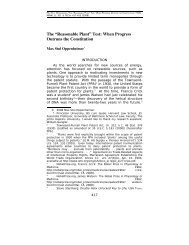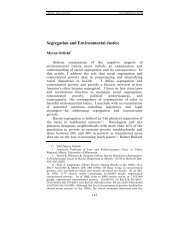An Organizational Approach to the Design of Patent Law
An Organizational Approach to the Design of Patent Law
An Organizational Approach to the Design of Patent Law
Create successful ePaper yourself
Turn your PDF publications into a flip-book with our unique Google optimized e-Paper software.
6 VERTINSKY FINAL_JAD (DO NOT DELETE) 2/27/2012 2:20 PM<br />
2012] AN ORGANIZATIONAL APPROACH 243<br />
Incorporating <strong>the</strong> cognitive level in<strong>to</strong> <strong>the</strong> institutional environment<br />
provides an opportunity <strong>to</strong> explore both <strong>the</strong> importance<br />
<strong>of</strong> mental models in constraining behavior relevant <strong>to</strong><br />
innovation, such as risk taking, and potential avenues for responding<br />
<strong>to</strong> <strong>the</strong>se limitations through, for example, patent law<br />
change. 142 Experimental economics, behavioral economics, and<br />
experimental psychology may provide underutilized avenues<br />
for exploring <strong>the</strong>se aspects <strong>of</strong> human learning and decision<br />
making and <strong>the</strong>ir implications for <strong>the</strong> design <strong>of</strong> patent laws. 143<br />
2. Embedded Institutions (Informal Rules)<br />
Informal rules include <strong>the</strong> norms, values, cus<strong>to</strong>ms, and<br />
conventions that shape behavior relevant <strong>to</strong> systems <strong>of</strong> innovation.<br />
144 For example, <strong>the</strong>y include both informal rules that influence<br />
how science and technology are “produced” and resulting<br />
innovations developed and deployed, 145 and informal rules<br />
that influence <strong>the</strong> evolution <strong>of</strong> patent laws and <strong>the</strong>ir effectiveness.<br />
Policy analysis under <strong>the</strong> organizational approach requires<br />
<strong>the</strong> study <strong>of</strong> <strong>the</strong> different aspects <strong>of</strong> <strong>the</strong> embeddedness <strong>of</strong><br />
innovation—whe<strong>the</strong>r cultural, structural, or political—and <strong>the</strong><br />
implications that <strong>the</strong> embeddedness has for patent policy. 146 Informal<br />
rules depend on existing political, social, and cognitive<br />
NORTH, INSTITUTIONS, INSTITUTIONAL CHANGE AND ECONOMIC PERFORMANCE<br />
85–86 (1990).<br />
142. See Williamson, supra note 75, at 600.<br />
143. Experimental psychology and behavioral economics may provide insights<br />
in<strong>to</strong> how individuals respond <strong>to</strong> different risk-reward systems as well as<br />
on transformational aspects <strong>of</strong> creating ownership over intangibles. E.g., <strong>An</strong>drew<br />
W. Torrance & Bill Tomlinson, <strong>Patent</strong>s and <strong>the</strong> Regress <strong>of</strong> Useful Arts, 10<br />
COLUM. SCI. & TECH. L. REV. 130, 140–42 (2009) (discussing <strong>the</strong> use <strong>of</strong> games<br />
and simulations <strong>to</strong> investigate how ac<strong>to</strong>rs respond <strong>to</strong> various patent situations).<br />
144. See Williamson, Transaction Cost Economics: How it Works; Where it<br />
is Headed, 146 DE ECONOMIST 23, 26–29 (1998).<br />
145. See, e.g., BRUNO LATOUR, SCIENCE IN ACTION: HOW TO FOLLOW<br />
SCIENTISTS AND ENGINEERS THROUGH SOCIETY 15–17 (1987) (<strong>of</strong>fering a contested<br />
approach <strong>to</strong> <strong>the</strong> empirical study <strong>of</strong> science and technology which emphasizes<br />
that science and technology must be studied “in <strong>the</strong> making,” and<br />
looking at <strong>the</strong> social construction <strong>of</strong> science through <strong>the</strong> study <strong>of</strong> labora<strong>to</strong>ry<br />
processes and systems). While many may disagree with La<strong>to</strong>ur’s view <strong>of</strong> <strong>the</strong><br />
social construction <strong>of</strong> science, he <strong>of</strong>fers a useful perspective on <strong>the</strong> different<br />
types <strong>of</strong> formal and informal rules that <strong>to</strong>ge<strong>the</strong>r channel economic activity.<br />
146. Williamson, supra note 75, at 597. See e.g. Rochelle Cooper Dreyfuss,<br />
Does IP Need IP? Accommodating Intellectual Production Outside <strong>the</strong> Intellectual<br />
Property Paradigm, 31 CARDOZO L. REV. 1437, 1443–47 (2010) (<strong>of</strong>fering<br />
an example <strong>of</strong> <strong>the</strong> importance <strong>of</strong> embedded analysis in <strong>the</strong> context <strong>of</strong> evaluating<br />
open systems <strong>of</strong> innovation).






